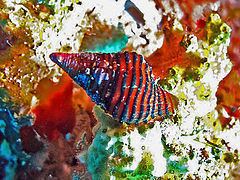Family Buccinidae | Superfamily Buccinoidea Subfamily Pisaniinae Rank Species | |
 | ||
Similar Pollia, Pollia fumosa, Cantharus, Phos senticosus, Antillophos | ||
Pollia undosa
Pollia undosa, common name : the waved goblet, is a species of sea snail, a marine gastropod mollusk in the family Buccinidae, the true whelks.
Contents
Description
The shell size varies between 20 mm and 45 mm, with the average size ranging from 35 mm to 40 mm. Usually the shell has dark brown ribs and orange background, but there are several different variations of color. It is an active hunter of other molluscs, feeding on snails, slugs, mussels and clams.
The ovate, bi-conic shell is quite thick and solid. It is of a reddish white, and covered with a brown, velvety epidermis. The six whorls are moderate, pretty distinct, and provided with decurrent, subnodulous striae, of a brownish or blackish red. The intervals are white, and furnished with very fine striae scarcely apparent. The body whorl is much larger than all the others together, and has five or six thick, obtuse longitudinal folds of ribs, which are rarely continued as far as the base of the shell, and oftentimes form only tubercles, particularly in old shells. The aperture is ovate, elongated, whitish, and bordered with yellow. The siphonal canal is slightly prolonged, emargination slight and oblique. The outer lip, which is thickened by age, is denticulated throughout its whole length, and furrowed internally. The columella is wrinkled and covered at its base with a thin, raised callosity.
Distribution
This species is distributed in the Red Sea, in the Indian Ocean along Aldabra, Chagos and Tanzania and in the Western Pacific Ocean. This species mainly inhabits reef and lagoons but it is widespread in a variety of different habitats.
